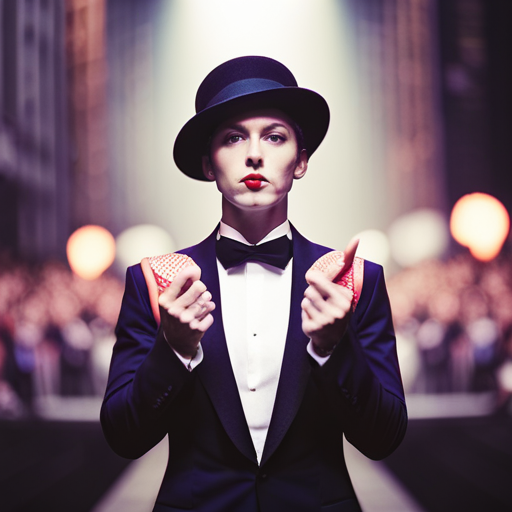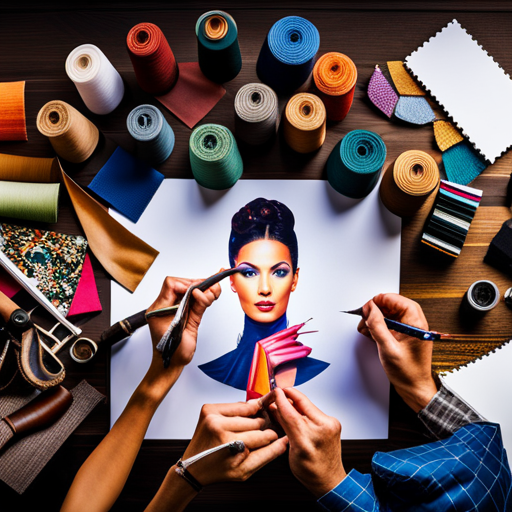The Science of Costume Movement and Flow

In the world of performing arts, the interaction between costume and movement is a delicate and fascinating dance. This article delves into the intricate science behind costume movement and flow, exploring the physics of fabric, body mechanics, and the art of enhancing emotions through fluid costumes.
From practical considerations to techniques for amplifying movement, this exploration offers valuable insights for costume designers and performers seeking to convey dynamic expression through the art of costume design.
The Physics of Fabric Movement
The Physics of Fabric Movement explores the mechanics and dynamics of how different textiles behave when in motion. Fabric dynamics involve the study of how fabrics move, fold, and drape in response to external forces. Understanding fluid motion is crucial in comprehending fabric flow, as it enables the prediction of how different materials will behave when worn or manipulated. Kinetic energy plays a pivotal role in fabric movement, as it determines the amount of energy stored within the fabric due to its motion. This energy influences the way the fabric moves and interacts with the surrounding environment.
The study of fabric movement is essential in costume design, as it allows designers to predict how a costume will behave when an actor is in motion. By understanding fabric dynamics and fluid motion, designers can create costumes that not only look aesthetically pleasing but also allow for freedom of movement. This understanding serves as a foundation for the subsequent section, which delves into the importance of comprehending body mechanics and its impact on costume design.
Understanding Body Mechanics and Costume Design
Understanding the intricate relationship between body mechanics and costume design is essential for creating impactful character portrayals on stage or screen. The way in which a costume interacts with the performer’s movements can greatly enhance the authenticity and dynamism of the character being portrayed.
Furthermore, the choice of fabric and its impact on movement is a critical consideration in the design process, as it directly influences the visual and emotional impact of the performance.
Movement and Costume Interaction
When designing costumes, it is essential to consider the interaction between the body’s mechanics and the costume’s design. This interaction significantly impacts the overall look and functionality of the costume. Understanding body movement and costume construction is crucial for achieving a seamless and visually appealing costume.
Here are four key points to consider in this regard:
-
Flexibility: Costumes should allow for a full range of motion to accommodate the body’s natural movement.
-
Weight distribution: Proper weight distribution in costume design is essential for maintaining balance and preventing strain on the body.
-
Durability: The costume’s construction should withstand the physical demands placed on it during performances or activities.
-
Aesthetic appeal: Balancing functionality with visual appeal is vital to ensure that the costume enhances the body’s movements and overall performance.
Enhancing Character Portrayal
To effectively enhance character portrayal through costume design, a thorough grasp of body mechanics is imperative. Character expression is not only conveyed through facial and vocal cues but also through physical movements. Understanding how the body moves and the emotions it conveys is crucial in creating costumes that complement and enhance the character’s portrayal.
Costume dynamics play a significant role in this process, as flowing fabric can add depth and dimension to the character’s movements, creating a sense of emotional connection between the character and the audience. The way a costume moves with the body can accentuate the character’s personality, further immersing the audience in the story.
Fabric Choice Impact
Incorporating the principles of body mechanics into costume design requires careful consideration of fabric choices to optimize the impact of costume movement and flow. When selecting fabric for costume design, several factors should be taken into account to ensure the desired impact of material and costume flow:
-
Flexibility: The fabric should provide enough stretch and flexibility to allow for a full range of motion without impeding the natural movements of the body.
-
Weight: The weight of the fabric can significantly impact the way a costume moves. Lighter fabrics may flow more freely, while heavier fabrics can create a more dramatic and structured effect.
-
Drape: The way a fabric drapes over the body can enhance or detract from the natural flow of movement, affecting the overall visual impact of the costume.
-
Breathability: Consideration of the breathability of the fabric is essential to ensure the comfort and ease of movement for the performer, especially during physically demanding scenes.
Enhancing Emotions Through Flowing Costumes
Enhancing emotions through the use of flowing costumes can profoundly impact the audience’s perception of the character’s emotional state. Emotional expression is a crucial element in costume design, and the use of flowing fabric can significantly enhance the portrayal of character emotions.
Flowing costumes have the ability to convey a wide range of emotions through movement and visual aesthetics. The way fabric drapes, billows, or flows around a character can effectively communicate feelings of joy, sorrow, excitement, or despair.
Costume designers strategically utilize the properties of different fabrics to amplify the emotional depth of a character. For instance, flowing silk or chiffon can evoke a sense of elegance, grace, and romance, while heavy, flowing fabrics like velvet or taffeta may convey a more dramatic and intense emotional presence.
The movement of the fabric as the character interacts with their environment can further emphasize their emotional journey, creating a captivating visual narrative for the audience. In this way, the use of flowing costumes becomes a powerful tool for evoking and enhancing emotions, enriching the overall storytelling experience.
Utilizing Color and Texture for Dynamic Movement
Costume designers enhance the dynamic movement of costumes by strategically incorporating color and texture. This not only adds visual interest but also influences the overall impact of the costume on stage or screen. When it comes to utilizing color and texture for dynamic movement, there are several key considerations to keep in mind:
-
Color psychology: Understanding the psychological effects of different colors can help designers evoke specific emotions and moods through costumes, enhancing the overall impact of the performance.
-
Fabric composition: The choice of fabric can significantly impact the way a costume moves. Light, flowing fabrics can create a sense of ethereal movement, while heavier fabrics can add weight and drama to the overall look.
-
Texture contrast: Incorporating contrasting textures can add depth and dimension to a costume, creating visual interest as the performer moves across the stage.
-
Visual impact: Bold, vibrant colors can draw attention and create a striking visual impact, while subtle, muted tones can lend an air of elegance and sophistication to the costume.
Considering these elements can help designers create costumes that not only look visually stunning but also enhance the dynamic movement of the performers.
Now, let’s delve into the practical considerations for fluid costume design.
Practical Considerations for Fluid Costume Design
When designing costumes for fluid movement, it is crucial to consider the impact of fabric weight on the overall flow.
Additionally, minimizing movement restrictions through strategic design and construction is essential for enhancing the fluidity of costume movement.
Incorporating flow-enhancing design elements can further contribute to the practical considerations for creating costumes that allow for effortless and graceful movement on stage or screen.
Fabric Weight Impact
As designers seek to optimize the movement and flow of costumes, practical considerations for fluid costume design must account for the impact of fabric weight. Understanding the fabric weight’s impact on costume dynamics is crucial for creating garments that move gracefully with the wearer.
Here are four key points to consider:
-
Fabric Selection: The choice of fabric weight significantly affects how the costume drapes and moves.
-
Movement Restrictions: Heavier fabrics may restrict the range of motion, while lighter fabrics can enhance fluidity.
-
Visual Aesthetics: Fabric weight influences the visual appeal of the costume in motion.
-
Practicality: Balancing the desired aesthetic with the practicality of fabric weight is essential for ensuring the costume is both visually stunning and functional.
Movement Restriction Minimization
To minimize movement restrictions in costume design, designers must carefully consider the interplay between fabric weight and the wearer’s range of motion. Flexibility optimization and comfort prioritization are crucial in achieving this balance.
Designers should prioritize materials that allow for enhanced range of motion, enabling mobility enhancement for the wearer. This involves selecting fabrics that are lightweight and possess inherent stretch and flexibility.
Additionally, strategic seam placement and construction techniques can further contribute to reducing movement constraints.
By integrating these considerations into costume design, the wearer’s comfort and ability to move freely are prioritized, ultimately enhancing the overall performance experience.
Now, let’s delve into the subsequent section about ‘flow-enhancing design elements’ to explore how costume design can further facilitate fluid movement and aesthetic appeal.
Flow-Enhancing Design Elements
Continuing the discussion on movement restriction minimization, the integration of flow-enhancing design elements in costume design plays a pivotal role in facilitating fluid movement and enhancing aesthetic appeal.
To achieve optimal flow dynamics and design aesthetics, consider the following practical considerations:
-
Fabric Selection: Utilize lightweight and breathable fabrics to allow for natural draping and movement.
-
Strategic Seaming: Incorporate curved and bias-cut seams to enable the costume to move seamlessly with the body.
-
Layering Techniques: Implement layering to add depth and dimension while maintaining freedom of movement.
-
Embellishments Placement: Place embellishments thoughtfully to complement movement and create visual interest without impeding flow.
Techniques for Amplifying Movement in Costumes
Enhancing the movement of costumes requires a meticulous understanding of fabric properties and design principles. When it comes to techniques for amplifying movement in costumes, construction plays a pivotal role.
The way a costume is constructed greatly affects its ability to move and flow. Choosing fabrics with the right weight, drape, and stretch is essential. For instance, lightweight fabrics like chiffon and silk can create graceful, flowing movements, while stretch fabrics allow for flexibility and ease of movement.
Additionally, incorporating design elements such as pleats, gathers, and drapes can add visual interest and amplify the costume’s movement. These elements create dynamic lines and shapes that enhance the overall visual impact of the costume as it moves.
Furthermore, strategic placement of seams and panels can also affect how a costume moves. By understanding the relationship between costume construction and visual impact, designers can maximize the potential for movement in their creations, resulting in costumes that captivate the audience with their fluidity and grace.
Frequently Asked Questions
How Does Culture and Historical Context Influence the Movement and Flow of Costumes?
The movement and flow of costumes are significantly influenced by cultural norms and historical context. These factors impact fabric weight, design, and overall construction, shaping how costumes move and interact with the wearer and their surroundings.
Can the Weight and Type of Fabric Affect the Overall Movement and Flow of a Costume?
The weight and type of fabric play a crucial role in shaping the movement and flow of a costume. These factors, akin to a choreographer guiding a dancer, influence the overall design and cultural influence of the garment.
Are There Specific Techniques for Creating Costumes That Enhance the Movement and Flow in Different Dance Styles or Performance Genres?
Costume design involves the strategic selection of fabrics and construction techniques to enhance movement and flow in different dance styles or performance genres. Understanding the specific requirements of each style is crucial for creating costumes that facilitate optimum performance.
What Role Does Lighting and Stage Design Play in Accentuating the Movement and Flow of Costumes?
Lighting design and stage layout are crucial in accentuating the movement and flow of costumes. By understanding fabric properties and cultural influences, designers can create an immersive experience that complements the performance and enhances the visual impact.
How Do Costume Designers Collaborate With Choreographers and Performers to Ensure That the Movement and Flow of Costumes Align With the Artistic Vision of a Production?
Costume collaboration in theater involves intricate partnerships between designers, choreographers, and performers. It ensures that artistic expression aligns with fabric impact, enhancing the production’s visual storytelling. This collaboration highlights the seamless integration of movement and costume design.
Conclusion
In conclusion, the science of costume movement and flow is a fascinating and intricate field that combines physics, body mechanics, and design principles.
By understanding the dynamics of fabric movement, utilizing color and texture, and implementing practical techniques, costume designers can create visually stunning and emotionally impactful costumes that enhance the overall performance.
The art of costume movement is truly a marvel that adds an extra layer of magic to any production.

Rufus Whitver is a passionate costume artisan and the creative mind behind layuo.com. With a keen eye for detail and a flair for imaginative design, Rufus brings characters to life through the art of costume making. His expertise encompasses a wide range of styles, from historical recreations to fantastical creations. Through layuo.com, Rufus shares insights, tutorials, and a portfolio showcasing his exceptional craftsmanship, inspiring fellow enthusiasts to embark on their own journey into the world of stunning costumes.





